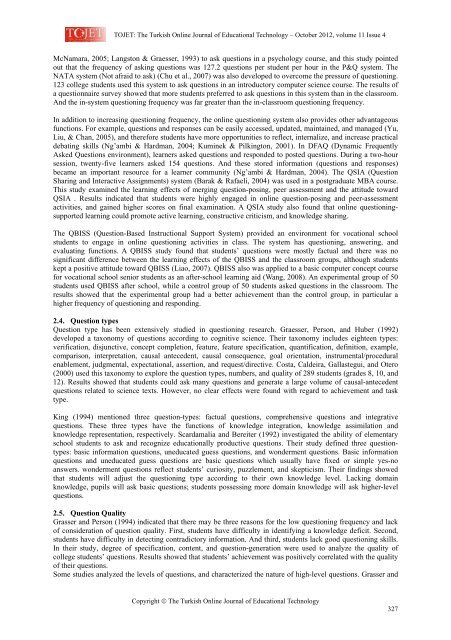october 2012 - TOJET the Turkish online journal of educational ...
october 2012 - TOJET the Turkish online journal of educational ...
october 2012 - TOJET the Turkish online journal of educational ...
Create successful ePaper yourself
Turn your PDF publications into a flip-book with our unique Google optimized e-Paper software.
<strong>TOJET</strong>: The <strong>Turkish</strong> Online Journal <strong>of</strong> Educational Technology – October <strong>2012</strong>, volume 11 Issue 4<br />
McNamara, 2005; Langston & Graesser, 1993) to ask questions in a psychology course, and this study pointed<br />
out that <strong>the</strong> frequency <strong>of</strong> asking questions was 127.2 questions per student per hour in <strong>the</strong> P&Q system. The<br />
NATA system (Not afraid to ask) (Chu et al., 2007) was also developed to overcome <strong>the</strong> pressure <strong>of</strong> questioning.<br />
123 college students used this system to ask questions in an introductory computer science course. The results <strong>of</strong><br />
a questionnaire survey showed that more students preferred to ask questions in this system than in <strong>the</strong> classroom.<br />
And <strong>the</strong> in-system questioning frequency was far greater than <strong>the</strong> in-classroom questioning frequency.<br />
In addition to increasing questioning frequency, <strong>the</strong> <strong>online</strong> questioning system also provides o<strong>the</strong>r advantageous<br />
functions. For example, questions and responses can be easily accessed, updated, maintained, and managed (Yu,<br />
Liu, & Chan, 2005), and <strong>the</strong>refore students have more opportunities to reflect, internalize, and increase practical<br />
debating skills (Ng’ambi & Hardman, 2004; Kuminek & Pilkington, 2001). In DFAQ (Dynamic Frequently<br />
Asked Questions environment), learners asked questions and responded to posted questions. During a two-hour<br />
session, twenty-five learners asked 154 questions. And <strong>the</strong>se stored information (questions and responses)<br />
became an important resource for a learner community (Ng’ambi & Hardman, 2004). The QSIA (Question<br />
Sharing and Interactive Assignments) system (Barak & Rafaeli, 2004) was used in a postgraduate MBA course.<br />
This study examined <strong>the</strong> learning effects <strong>of</strong> merging question-posing, peer assessment and <strong>the</strong> attitude toward<br />
QSIA . Results indicated that students were highly engaged in <strong>online</strong> question-posing and peer-assessment<br />
activities, and gained higher scores on final examination. A QSIA study also found that <strong>online</strong> questioningsupported<br />
learning could promote active learning, constructive criticism, and knowledge sharing.<br />
The QBISS (Question-Based Instructional Support System) provided an environment for vocational school<br />
students to engage in <strong>online</strong> questioning activities in class. The system has questioning, answering, and<br />
evaluating functions. A QBISS study found that students’ questions were mostly factual and <strong>the</strong>re was no<br />
significant difference between <strong>the</strong> learning effects <strong>of</strong> <strong>the</strong> QBISS and <strong>the</strong> classroom groups, although students<br />
kept a positive attitude toward QBISS (Liao, 2007). QBISS also was applied to a basic computer concept course<br />
for vocational school senior students as an after-school learning aid (Wang, 2008). An experimental group <strong>of</strong> 50<br />
students used QBISS after school, while a control group <strong>of</strong> 50 students asked questions in <strong>the</strong> classroom. The<br />
results showed that <strong>the</strong> experimental group had a better achievement than <strong>the</strong> control group, in particular a<br />
higher frequency <strong>of</strong> questioning and responding.<br />
2.4. Question types<br />
Question type has been extensively studied in questioning research. Graesser, Person, and Huber (1992)<br />
developed a taxonomy <strong>of</strong> questions according to cognitive science. Their taxonomy includes eighteen types:<br />
verification, disjunctive, concept completion, feature, feature specification, quantification, definition, example,<br />
comparison, interpretation, causal antecedent, causal consequence, goal orientation, instrumental/procedural<br />
enablement, judgmental, expectational, assertion, and request/directive. Costa, Caldeira, Gallastegui, and Otero<br />
(2000) used this taxonomy to explore <strong>the</strong> question types, numbers, and quality <strong>of</strong> 289 students (grades 8, 10, and<br />
12). Results showed that students could ask many questions and generate a large volume <strong>of</strong> causal-antecedent<br />
questions related to science texts. However, no clear effects were found with regard to achievement and task<br />
type.<br />
King (1994) mentioned three question-types: factual questions, comprehensive questions and integrative<br />
questions. These three types have <strong>the</strong> functions <strong>of</strong> knowledge integration, knowledge assimilation and<br />
knowledge representation, respectively. Scardamalia and Bereiter (1992) investigated <strong>the</strong> ability <strong>of</strong> elementary<br />
school students to ask and recognize <strong>educational</strong>ly productive questions. Their study defined three questiontypes:<br />
basic information questions, uneducated guess questions, and wonderment questions. Basic information<br />
questions and uneducated guess questions are basic questions which usually have fixed or simple yes-no<br />
answers. wonderment questions reflect students’ curiosity, puzzlement, and skepticism. Their findings showed<br />
that students will adjust <strong>the</strong> questioning type according to <strong>the</strong>ir own knowledge level. Lacking domain<br />
knowledge, pupils will ask basic questions; students possessing more domain knowledge will ask higher-level<br />
questions.<br />
2.5. Question Quality<br />
Grasser and Person (1994) indicated that <strong>the</strong>re may be three reasons for <strong>the</strong> low questioning frequency and lack<br />
<strong>of</strong> consideration <strong>of</strong> question quality. First, students have difficulty in identifying a knowledge deficit. Second,<br />
students have difficulty in detecting contradictory information. And third, students lack good questioning skills.<br />
In <strong>the</strong>ir study, degree <strong>of</strong> specification, content, and question-generation were used to analyze <strong>the</strong> quality <strong>of</strong><br />
college students’ questions. Results showed that students’ achievement was positively correlated with <strong>the</strong> quality<br />
<strong>of</strong> <strong>the</strong>ir questions.<br />
Some studies analyzed <strong>the</strong> levels <strong>of</strong> questions, and characterized <strong>the</strong> nature <strong>of</strong> high-level questions. Grasser and<br />
Copyright © The <strong>Turkish</strong> Online Journal <strong>of</strong> Educational Technology<br />
327
















